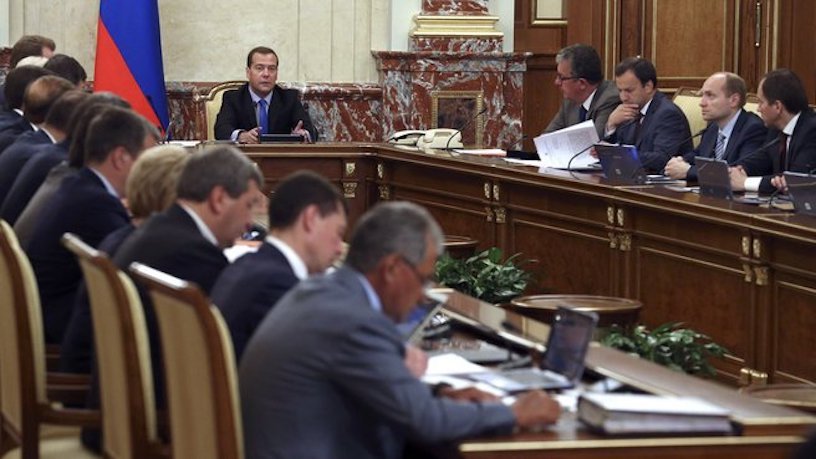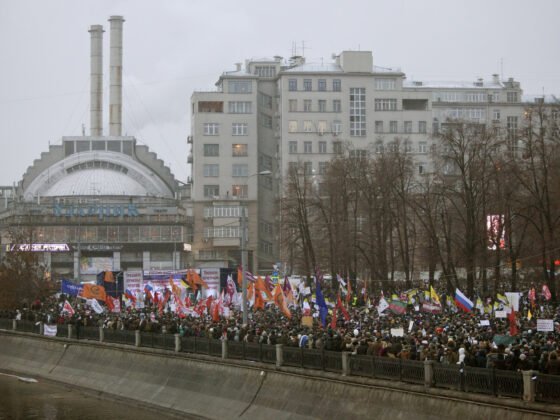(PONARS Eurasia Policy Memo) Western sanctions on Russia have failed demonstratively to secure Moscow’s formal compliance with stated objectives. Both sides seem worlds apart in their expectations and approaches; expert communities and policymakers have embraced fundamentally different understandings of the meaning, objectives, processes, and legitimacy of sanctions-related behavior. This reinforces asymmetrical preferences, muddles threats, rationalizes costs, and thwarts tailored initiatives, while affirming each side’s parochial assessments of its leverage over the other, stoking escalation. Applying data analytical techniques to examine respective discourses on the matter, we reveal that neither deadlock nor uncertainty are the likely prime drivers of the gap between the “high incidence and low effectiveness” of Western-Russian sanctions behavior. The best bets—given cross-domain responses and divergent worldviews—may lie with either closing ranks with Western allies to offer dramatic gestures for re-setting the broader strategic agenda with Russia, or building understanding of each side’s assumptions by engaging Moscow in the design and tactical applications of future sanctions directed at third parties of mutual concern.
Mutual Complacency in the Sanctions Tangle
There is a curious paradox between the escalation of sanctions between the United States/EU and Russia and their ineffectiveness at achieving explicit and tangible objectives. Despite doubling down on the frequency and intensity, Western sanctions on Russia have failed demonstratively to secure Russia’s formal compliance with such aims as restoring Ukraine’s sovereignty over Crimea, implementing fully the Minsk accords, admitting guilt in ordering the Skripal attack, withdrawing support for the Assad regime, and refraining from election meddling. While the volume of Russian gas exports to Europe has increased in the face of targeted sanctions on the energy sector, the promise of secondary sanctions—which historically have hit European firms harder than American ones—has excited transatlantic debate over energy security and burden-sharing in standing up to Russia.
Similarly, Moscow’s “reciprocal” ban on food imports from the United States, EU, Norway, Canada, and Australia, as well as attempts at monetary and trade diversification, have yielded paltry strategic results. This is confounded by ad hoc exemptions to the embargo on European agricultural imports, Belarus’ emergence as a willing re-exporter, Russia’s restricted trade footprint and dependence on Western financial systems, and the declining purchasing power of Russian consumers. Moscow also has failed outright to stem escalation—costing the Russian economy upwards of 1.5 percent GDP per annum and reducing the profitability of targeted firms—or to drive an effective political wedge between Western partners with different stakes and levels of hostility towards trade with Russia.
Despite no end in sight, there is mutual complacency about the increasingly costly, if not risky, U.S.-Russian sanctions tangle. It is widely accepted across Washington that sanctions are the “least bad option” to protest Russia’s malign behavior, and the escalating intensity of these sanctions is seen as a low cost approach to demonstrating resolve to both foreign and domestic audiences, even if they are not effective in softening up Russian targets or deterring more egregious offensives by the Kremlin. Similarly, Russian officials trumpet the resilience of the political economic system in the face of Western sanctions. They are strategically emboldened by seeming invulnerability to Western economic pressure and confidence at import substitution and “de-problematizing” sanctions to the Russian public. At the crux of respective postures are presumptions that the sides are either deadlocked with conflicting strategies pursued for domestic purposes, or that the respective sender needs to take more forceful action to convince the other ultimately to back down.
Applying both events and text-mining data analytical techniques to examine respective discourses, we discern that neither deadlock nor uncertainty are the likely prime reasons for the “high incidence-low effectiveness” gap in sanctions behavior. Instead, both sides appear to be “worlds apart” in their expectations and approaches to sanctions. Rather than pursuing “reciprocal sanctions” or simply being satisfied with domestic efforts to blunt the impact of Western trade restrictions, Moscow is prone to respond to Western economic sanctions by escalating broader forms of coercion across different policy areas. Furthermore, Western and Russian strategic communities embrace fundamentally different understandings of the meaning, objectives, processes, and legitimacy of sanctions-related behavior. Together, orthogonal behavior (meaning not being influenced by each other in the intended way and provoking a cross-domain rather than reciprocal response) and contending worldviews related to sanctions overshadow all plans and initiatives while affirming each side’s parochial assessments of its leverage over the other and stoking dangerous escalation that is otherwise masked by wishful thinking or a fixation on domestic audience costs.
The Sanctions Problematique
Economic sanctions are tools of statecraft aimed at withholding economic and financial exchange to advance foreign policy objectives. Typically, they are designed to impose pain on a target so that the costs of compliance outweigh the benefits of resistance, while presenting a cost-effective option for the “sender” (the sanctioning state). Sanctions can be directed toward different ends—deterring future action, punishing/forcing regime change, signaling discontent, upholding a norm—and come in different forms. Accordingly, sanctions are intrinsically dynamic, whereby the impact—costs imposed on a target—is shaped by the interaction among sending, target, and third parties to affect the ultimate success—the attainment of specific objectives of the states imposing sanctions.
This sanctions equation rests on three basic assumptions. First, senders and targets are presumed to rationally calculate costs, benefits, and probabilities in respective decisions to impose or comply with sanctions. Second, sanctions succeed when they impose significant costs on relevant targets; they fail when the link between economic impact and policy influence is disrupted. Third, they work when sanctions threats and the punishment imposed by senders are received as intended by targets. Given information asymmetries between international rivals, much attention is paid to a sender’s capacity to issue credible threats and demonstrate resolve to deliver painful punishment.
Yet, how pain is assessed and signals are received can be as much a function of how in tune a target is with a sender at processing them, cognitively or politically. Asymmetries in prior understandings concerning the legitimacy and efficacy of sanctions, for example, may lead targets to draw very different conclusions about the credibility or meaning of specific actions, irrespective of how transparent a sender may be at conveying the sincerity of threats or bluntness at imposing sanctions. Similarly, how a target perceives and chooses to respond to sanctions may vary; reciprocating with counter-sanctions is only one option. In the case of Russia, scholars are beginning to uncover not only contrasting cognitive frames that are used to evaluate respective interests and perceptions of threat posed by Western sanctions, but altogether different conceptualizations of the interplay between regional foreign policy priorities, the country’s position within global geo-economic structures, and prevailing business frames. The latter, in turn, shape the geographic scope, financial levers, and institutional features of Moscow’s sanctions-related behavior, as well as trigger divergent perceptions of threat from across economic sectors.
Cross-Domain Effects
The contemporary debate over the effectiveness of Western sanctions turns on assessment of Moscow’s behavioral response. As noted above, there is little tangible evidence of direct compliance with the specific sanctions regimes. However, more nuanced positions seek to evaluate the extent to which Moscow reciprocates or not with counter-sanctions, or otherwise responds asymmetrically to dampen the impact of Western sanctions. The latter can take the form of: diversifying non-Western trade ties; manipulating public support for the regime (rally around the flag effect); insulating targeted sectors and individuals from imposed costs; and/or bolstering the resilience of the national economy through import substitution, currency manipulation, and stimulation of domestic innovation.
A key feature relates to the diversity of Moscow’s international behavior surrounding the imposition of Western sanctions. GDELT and ICEWS1 datasets of millions of events from the mid-1990s make it possible to distinguish broad trends in Moscow’s sanctions-related international behavior. Using CAMEO taxonomy of sanctions-related codes associated with both datasets, our preliminary research reveals that since 2010 sanctions have not constituted a mainstay of Russia’s foreign policy, especially in comparison to the United States.
The trends become more nuanced, however, as they relate to nationally targeted sanctions. As depicted in Figure 1 (see the Appendix), Russia’s sanctions-related activity as a percentage of its overall foreign attention to the United States tracks closely with the analogous U.S. sanctions-related activity as a sub-set of events directed at Russia. There is a clear pattern of mirroring by Russia, with upticks in Russian sanctions events following nearly all upturns in U.S. sanctions targeting Russia. However, Russia’s reciprocal sanctions response appears muted, as its sanctions activity is a much less prominent feature of the actions it takes targeting the United States than are sanctions within U.S. actions targeting Russia.
Moreover, this broader empirical pattern does not reflect a straightforward, binary action-reaction dynamic between United States-Russia sanctions behavior. Rather, to the extent that there may be a “reactive” dimension, the “main events” may be more across-strategy/domain, rather than reciprocal. Specifically, U.S. sanctions targeted at Russia tend to correspond with more frequent and intensive surges in Russia’s overall coercive behavior—including verbal threats and material actions—directed at the West. Figure 2 illustrates that Russia’s coercion directed at the United States increases significantly following the imposition of U.S. targeted sanctions, with the frequency of Russian coercive action against the US consistently exceeding the frequency of U.S. sanctions actions against Russia, especially since the onset of the Ukrainian crisis in 2014.
Closer qualitative analysis of the details of these spikes reveals several potential avenues for future research. For example, Russia seems to embrace a discriminatory coercive response to U.S. sanctions, varying both the type and intensity of policy action. Moscow often deploys both diplomatic and legal forms of coercion against the United States prior to and during periods of U.S. imposed sanctions, arguing that these sanctions violate international law as well as Russia’s sovereignty. At the same time, Russia appears to couple its muted sanctions behavior with an increase in malign financing directed at Europe and other geographically differentiated coercive activities, including more frequent use of limited military force in Ukraine and Syria, possibly as part of a concerted, orthogonal response to Western sanctions. Furthermore, Russia’s malign financial statecraft is both more prevalent than its economic sanctions and energy coercion and directed primarily at the United States, Western Europe, and the NIS and much less at Central & Eastern Europe. Such tailored statecraft, however, does not seem to be preceded by graduated threats of imposing sanctions on the West.
Worlds Apart
Western and Russian worldviews are seemingly further apart when it comes to how they understand and conceive of sanctions. A close qualitative review of the key works in respective sanctions literatures reveals that whereas Russian scholarship is almost categorically pessimistic about the success of sanctions at altering foreign policy behavior, Western commentary is generally marked by debate over alternative conditions for infrequent success.
These distinctions become more pronounced with systematic bibliometric and text analyses of a curated corpus of 2,060 research articles on sanctions published since 2010 by Russian- and Western-based scholars and culled from Web of Science and SCOPUS, two highly respected and globally accessible citation indexes. The former reveals that despite the growing volume of publications on sanctions among both Russian and Western scholars, especially since the 2014 Ukraine crisis, the respective communities operate in isolation of each other and have little in common—publishing in different journals, citing different sources, and studying different sanctions-related topics.
Substantively, there is even greater distance, as depicted in Figure 3, which captures the results of applying machine-learning-enabled keyword co-occurrence mapping to the titles of the articles in the corpus. This reveals that while Western scholarship focuses primarily on the strategic dimensions of sanctions, Russian scholarship clusters narrowly around their macroeconomic impact, as well as the utility of asymmetrical responses including import substitution, domestic regulation, national innovation, and strategic trade diversification away from the West and towards India and China.
This is underscored in Table 4, which compares the most prominent themes within the articles written by Russian researchers with those authors based outside of Russia. These were extracted by applying the machine learning technique of LDA (Latent Dirichlet Allocation) topic modeling to the abstracts in the corpus, resulting in a set of topics represented by weighted clusters of frequently co-occurring terms. The LDA topic modeling highlights the Russian preoccupation with the domestic economic dimensions of blunting Western sanctions, as well as some overlap between the strategic communities in assessing the impact of sanctions in Russia and abroad.
Implications
The above events and text analyses reveal that the West and Russia may indeed be on very different planes when it comes to sanctions, with implications for refining U.S. policy. The events analyses suggest that Russia’s response to U.S. sanctions may be more broad-based and cross-domain than reciprocal, resulting in an opportunistic (rather than a coherent and graduated) and multifaceted reactive posture. This, in turn, may be suggestive of a tactical, ad hoc approach to sanctions that is nevertheless part of a more strategic approach to cross-domain, dynamic coercion in response to United States/EU sanctions. Accordingly, Western sanctions are not cost-free, and perpetuation of the status quo risks escalating challenges on multiple policy fronts, including domains where the United States and Europe may not be on the same page or enjoy competitive advantages.
More fundamentally, our text analyses underscore how the two strategic communities are “worlds apart” in understanding and assessing sanctions-related activity. For Washington, this means that efforts at signaling greater commitment by escalating pain on select Russian sectoral and individual targets are likely falling on deaf ears. Discrete sanctions not only risk conveying a lower Western pain threshold for sanctions, but do not resonate as legitimate within the Russian strategic community. The latter risks perversely fueling the Kremlin’s efforts to blunt, divert, distract or manipulate Western trading practices to bolster its position at home and abroad. Furthermore, contending worldviews on sanctions suggest that the risky status quo derives from neither deadlock nor uncertainty. Consequently, incremental steps at direct confidence-building and extending reciprocal concessions with sanctions relief may be simply too little, too late. Instead, the most productive course may lie with engaging Moscow on multilateral tactical applications of sanctions (and possibly inducements) directed at common third-party targets (e.g. North Korea) that avoid core contradictory interpretations associated with bilateral sanctions. Beyond that, given the risks associated with the escalation of direct sanctions, Western allies should close ranks either to fashion a coherent cross-domain counter-strategy to buffer Moscow’s broad-based coercive responses or offer dramatic gestures for re-setting the strategic agenda with Russia.
Adam N. Stulberg is Sam Nunn Professor and Chair, and Jonathan Darsey is PhD Candidate, in the Sam Nunn School of International Affairs at the Georgia Institute of Technology. The authors are grateful for the data analytical support provided by the Project RuBase team (Hague Center for Strategic Studies and Georgia Tech) and the partial financial support provided by Carnegie Corporation of New York.
[PDF]
[1] Both ICEWS (Integrated Crisis Early Warning System) and GDELT (Global Database of Events, Language, and Tone) are open-source, machine-coded datasets that seek to capture and characterize the international behavior and interactions of states. Each dataset is generated through the automated analysis of newspapers, magazines, blogs, and other online resources; similarly, each dataset utilizes the CAMEO event schema to characterize events. The datasets differ in the sources that they use, their size (GDELT is significantly larger), and the scraping and cleaning algorithms that they employ, and there is an active debate within the academic and policy communities about the relative strengths and weaknesses of each.
Homepage image credit.
Appendix
Figure 1: Russia and United States Comparative Use of Sanction in Interactions with the Other State
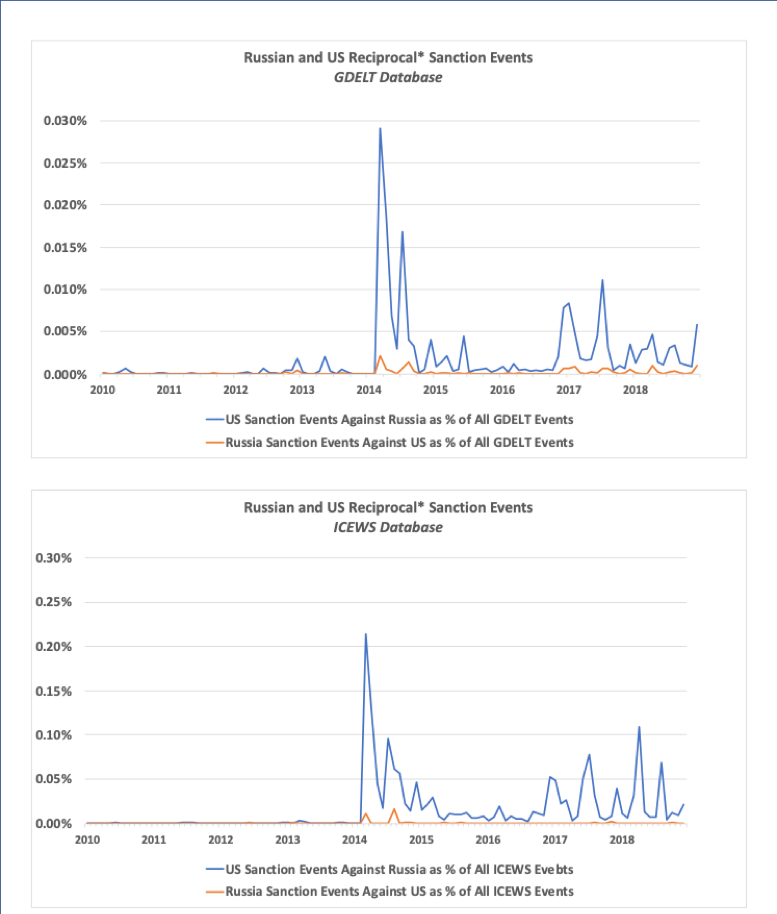
| Figure 1 Notes: 1. *‘Reciprocal sanctions’ are sanction event counts for Russian sanctions targeting the United States and U.S. sanctions targeting Russia. 2. ‘Sanction events’ were those events coded as either ‘impose sanctions,’ ‘threaten sanctions,’ or ‘refuse to remove sanctions’ in the datasets. |
Figure 2: U.S. Sanctions Targeting Russia and Russian Conflictual Events Targeting the United States
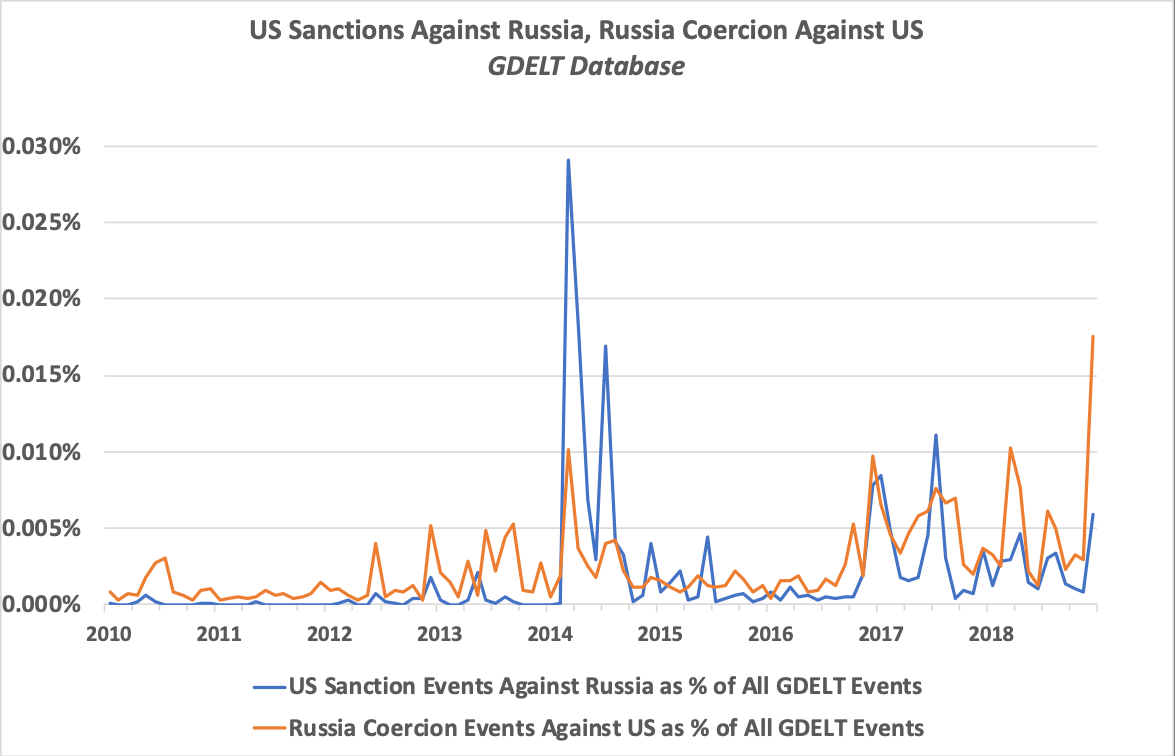
Figure 3: Relationship between Frequently Co-Occurring Terms in the Abstracts of Academic Articles on Sanctions
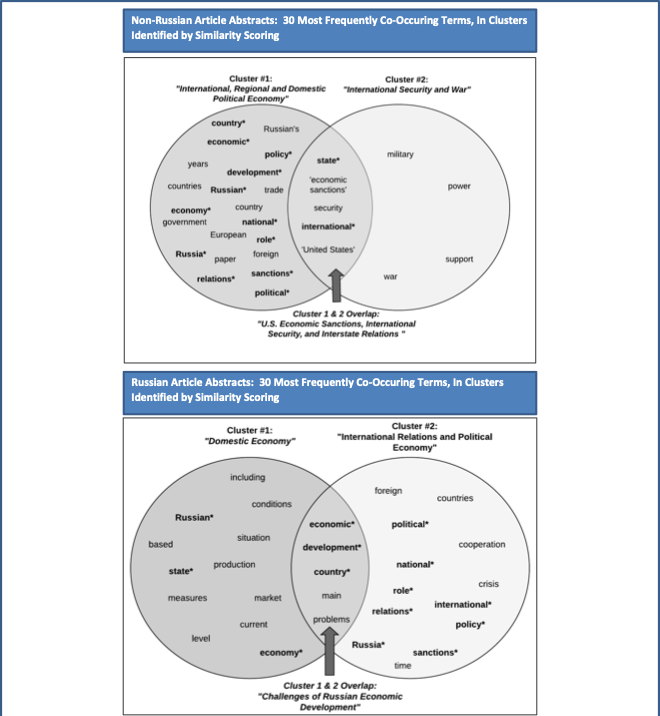
| Figure 3 Notes: 1. Terms were extracted automatically from abstracts, then a list of pairs of terms that both occurred in the same abstract was developed. The 30 most ‘distinctive’ pairs of these terms were identified using TF-IDF scores, a text mining statistic that emphasizes terms that appear multiple times in the same abstract. K-means clustering, an unsupervised machine learning algorithm similar to the one used by Google and other search engines, was then used to identify groups of these terms (‘clusters’) with statistically similar characteristics. 2. After reviewing these clusters, the authors developed the qualitative labels shown for each, such as ‘International Relations & Political Economy.’ 3. Terms that have bold are common across the co-occurrence diagrams generated from the Russian-authored and non-Russian authored abstracts. 4. The relative location of the different terms in each cluster conveys no additional meaning; they were arranged by the authors for readability. |
Table 4: Topics Extracted from Abstracts of Russian and Non-Russian Academic Articles on Sanctions
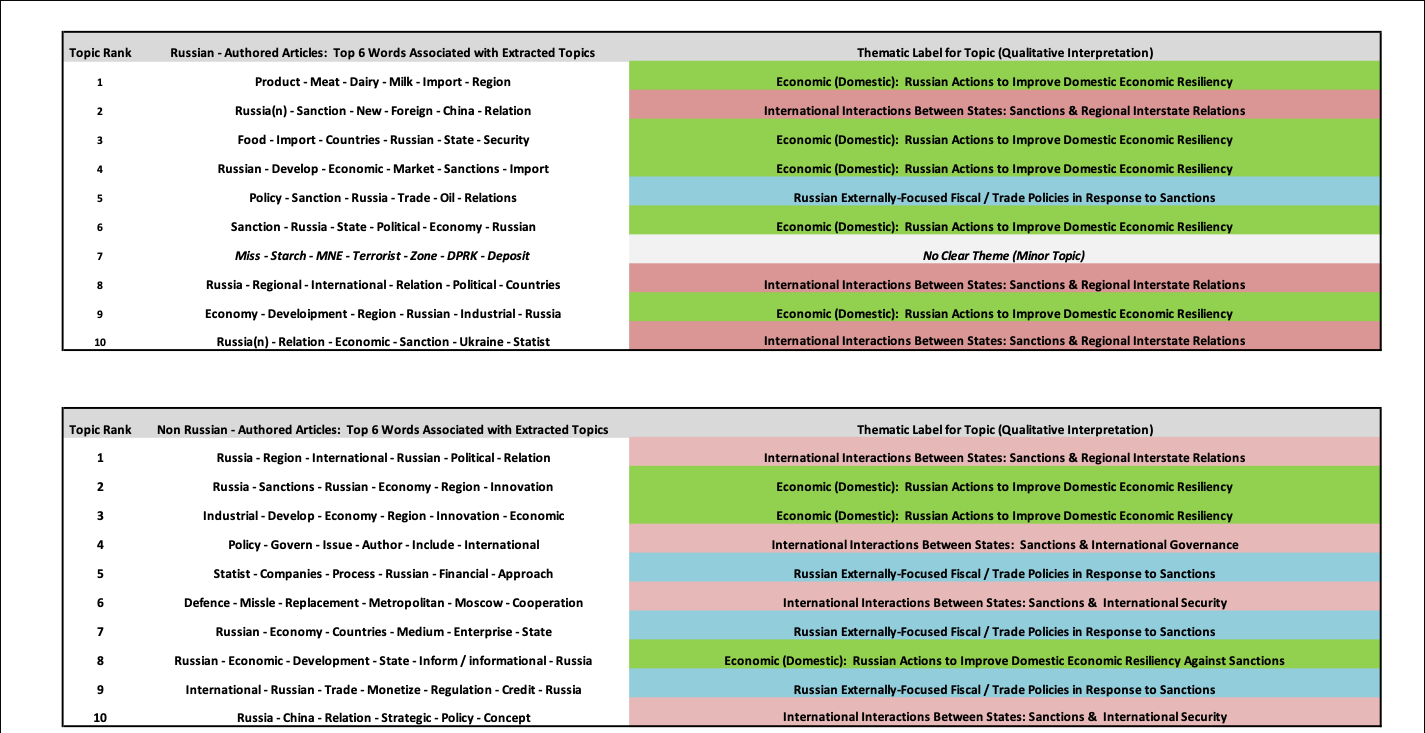
| Table 4 Notes: Topic models were extracted using Bibliometrix natural language software (on R-package). Project team used the institutional affiliation of the author(s) of each article to attribute each as either ‘Russian’ (one or more authors with Russian institutional affiliation) or ‘Non-Russian.’ Articles written by Russian and by Non-Russian authors were grouped and analyzed separately, resulting in two different sets of topics, associated words, and themes for each. For each group, the topics and associated words were identified by using a statistical assessment of the frequency that words in the abstracts tended to co-occur (i.e., appear in the same abstract). The thematic labels for each topic are qualitative interpretations of the themes that the mathematical topic models likely represent. The team developed these thematic labels by reviewing the mathematical models and the underlying associated abstracts together. |
Memo #: 633
Series: 2

